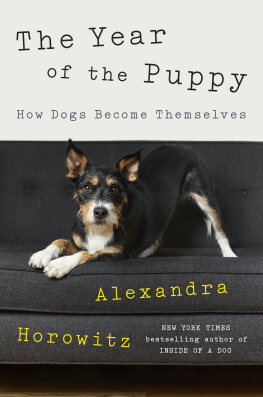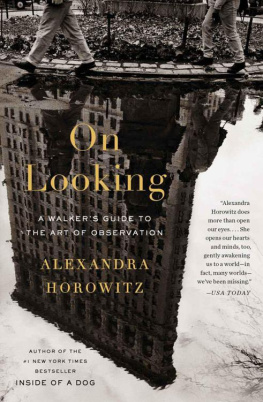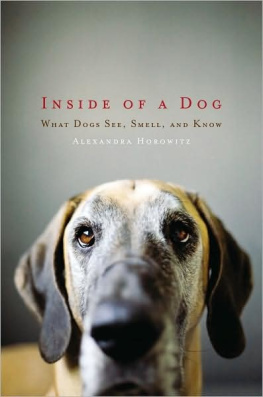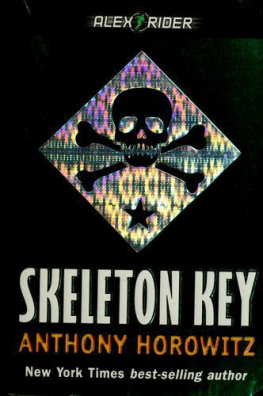Alexandra Horowitz - Being a Dog
Here you can read online Alexandra Horowitz - Being a Dog full text of the book (entire story) in english for free. Download pdf and epub, get meaning, cover and reviews about this ebook. year: 2016, publisher: Scribner, genre: Detective and thriller. Description of the work, (preface) as well as reviews are available. Best literature library LitArk.com created for fans of good reading and offers a wide selection of genres:
Romance novel
Science fiction
Adventure
Detective
Science
History
Home and family
Prose
Art
Politics
Computer
Non-fiction
Religion
Business
Children
Humor
Choose a favorite category and find really read worthwhile books. Enjoy immersion in the world of imagination, feel the emotions of the characters or learn something new for yourself, make an fascinating discovery.

- Book:Being a Dog
- Author:
- Publisher:Scribner
- Genre:
- Year:2016
- Rating:5 / 5
- Favourites:Add to favourites
- Your mark:
- 100
- 1
- 2
- 3
- 4
- 5
Being a Dog: summary, description and annotation
We offer to read an annotation, description, summary or preface (depends on what the author of the book "Being a Dog" wrote himself). If you haven't found the necessary information about the book — write in the comments, we will try to find it.
Being a Dog — read online for free the complete book (whole text) full work
Below is the text of the book, divided by pages. System saving the place of the last page read, allows you to conveniently read the book "Being a Dog" online for free, without having to search again every time where you left off. Put a bookmark, and you can go to the page where you finished reading at any time.
Font size:
Interval:
Bookmark:
Thank you for downloading this Scribner eBook.
Join our mailing list and get updates on new releases, deals, bonus content and other great books from Scribner and Simon & Schuster.
C LICK H ERE T O S IGN U P
or visit us online to sign up at
eBookNews.SimonandSchuster.com

for my Dad
Finnegans is ebony-black, moist, and dappled, two cavernous bass clefs at its front. Uptons is cleft with a visible valley, the whole thing guarded by short whiskers standing at attention.
These are my dogs, and these are my dogs noses.
Before I became a research scientist studying dog cognition, I didnt think much about the dog nose. It may have been frowned at when poking impolitely at the privates of visitors to my home, or dabbed with peanut butter to encourage the swallowing of a pill. Even then, though, little regard was given to the nose itselfto its form, to its movement, to the impossibly convoluted and complex vault it opens into.
This oversight isnt restricted to dog noses. We rarely study the nose on each others face. At the nose prominently displayedindeed, jutting out, leading the way for the rest of the body. Without looking, try to describe your partners nose, or your mothers. If its not beakish or buttony, well, its just a nose. Two nostrils dangling from a squashed, fleshy tetrahedron.
I gaze at my sons nose, but mostly at its surfacewhere the freckles have begun to assemble on his fair skin. But the snout of the dog gets my full attention. Now I look at dogs nose-first. For I am besotted with dogs, and to know a dog is to be interested in what its like to be a dog. And that all begins with the nose.

What the dog sees and knows comes through his nose, and the information that every dogthe tracking dog, of course, but also the dog lying next to you, snoring, on the couchhas about the world based on smell is unthinkably rich. It is rich in a way we humans once knew about, once acted on, but have since neglected.
By smelling, tapping into this sensory resource that we have but that we largely ignore, the dog has become an informant. Working dogs, trained to tell us what they naturally know, detect the presence of illegal substances and unwanted pests. But the dog also knows about the upcoming weather, the way afternoon smells, and whether you are sick or upset. Every inhaled gulp of air is full of information. It holds the odors of people who have recently passed by, leaving olfactory trails in their wake. It catches pollens and plant notes carried on the breeze. Each noseful captures the traces of animals who have walked, run, cowered, eaten, or died nearby. It traps the electric charge and round humid molecules from distant rainstorms.
This book is an exploration of what the dogs nose knows as has never been done before. What does your dog smell on you, on the ground, or with his nose deep in the fur of another dog? What does he know about youthat you might not know yourself? What is it like to smell the world with that amazing nose leading the dog through his days?
To find out, I tracked the tracking dogs. Over the last years I have watched detection dogs grow up, be trained, and find their quarry, be it drugs, food, or people. With my Dog Cognition Lab at Barnard College, I have researched the pet dogs experience of himself, other dogs, and the smells of the human world in which he lives. I have spoken to scientists who study and model the dog nose, and to trainers and handlers who follow it. It is an examination of all aspects of the dogs olfactory world, and the magnificent organ that leads to it.
But it is also an exploration of the noses on our faces. We have untrained ourselves, we humansunlearned how to smell, over millennia. We are out of the habit of smelling. Why, you may not even have smelled this book yet, though it is but inches from your face. I find people who are smelling, and practice their methods.
Having myself committed a lifetime of not smelling, I let my dogs behavior counsel me: I have ventured to be a little more like a dog myself. In my book Inside of a Dog I began an imaginative leap into what it might be like to be a dogand here I leap with four feet. I try to take my nose to the places the dog nose goes. And I sniff.
I begin this process by learning more about our own sense of smell. And then I train my nose to better conjure what it might be like to have the mind and nose of a dog.
My inspiration and guides are our familys own dogs, Finnegan and Upton. Both are highly charismatic mutts. My husband and I met Finnegans nose through the bars of a crate at a shelter that imports unwanted dogs from the South. He was four months old, had had ringworm and parvovirus, and, though recovering, was skinny and a bit sickly. I should say that I dont go to shelters much, because when I do, I inevitably walk out with a new animal. When I first saw him, in that crate at eye level, he wagged mightily, accepted a finger poked through the bars for licking, poked his nose through reciprocally, and then, as we moved on, sat down patiently. I looked back at him often: he was sitting and... waiting. We took him out of the crate to meet him, and he moved between my husband and me, looking at each of us in the face. Weary, he leaned against me. That was that. We took him home.
Finn is now eight years older. He still has the look of that puppy who leaned. While his coat is a glossy black, as though we polish him daily, it is his way of looking that most captures him. One gets the feeling that he is always aware of what is happening. His eyes penetrate us. They follow us, they check with us when another animal is misbehaving, they look to us dolefully when we head out the door. Ears back, eyes full, he is hard to leave. He does not look simply with his eyes: his nose examines us. When we return home, he sniffs us, as close as we will let him, in an exploration of where weve gone, what weve eaten, whom weve touched or pet. Never have I returned home, having met a dog on the street, and escaped Finns examination.
I tend to think of Finn as a professional dog. He is eminently civilized: without our explicitly teaching him, he fell into line with what we expect from a dog in the house. He swallowed the little culture of our family whole. Upton, by contrast, whom we met three years into his life, is feral by comparison. He had been relinquished to the shelter from which he was initially adopted three years prior. Weve seen his first photos: a small-bodied hound, ears too large for his head. Nose a blur. Well, his head and body grew up: hes a large, brindle, hound mix, with full eyes and a corkscrew tail. Whiskers punctuate his snout; his jowls droop. He is a dogs dog, incurably friendly with any dog, and has a gangly, goofy run. There is no photo of Upton in which he looks streamlined, athletic, or svelte. In running, his jowls flap, he tilts, his ears go akimbo. He is generously silly. Alas, he was also not a city dog before we knew him, and he is easily startled by every and any soundcar door, garbage truck, garage door opening, street sign shaking in the wind, jackhammer, a bag flapping in a tree, a person suddenly appearing from around the corner... you name it. For this reason, while I have followed both of their noses to whatever sundry and sordid spots theyre smelling, it is only Finn who I bring out to do new investigative smelling work. He could half write this book himself.

Font size:
Interval:
Bookmark:
Similar books «Being a Dog»
Look at similar books to Being a Dog. We have selected literature similar in name and meaning in the hope of providing readers with more options to find new, interesting, not yet read works.
Discussion, reviews of the book Being a Dog and just readers' own opinions. Leave your comments, write what you think about the work, its meaning or the main characters. Specify what exactly you liked and what you didn't like, and why you think so.









